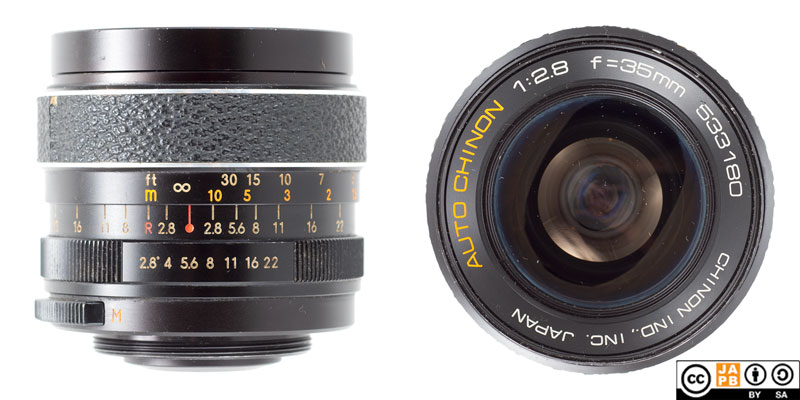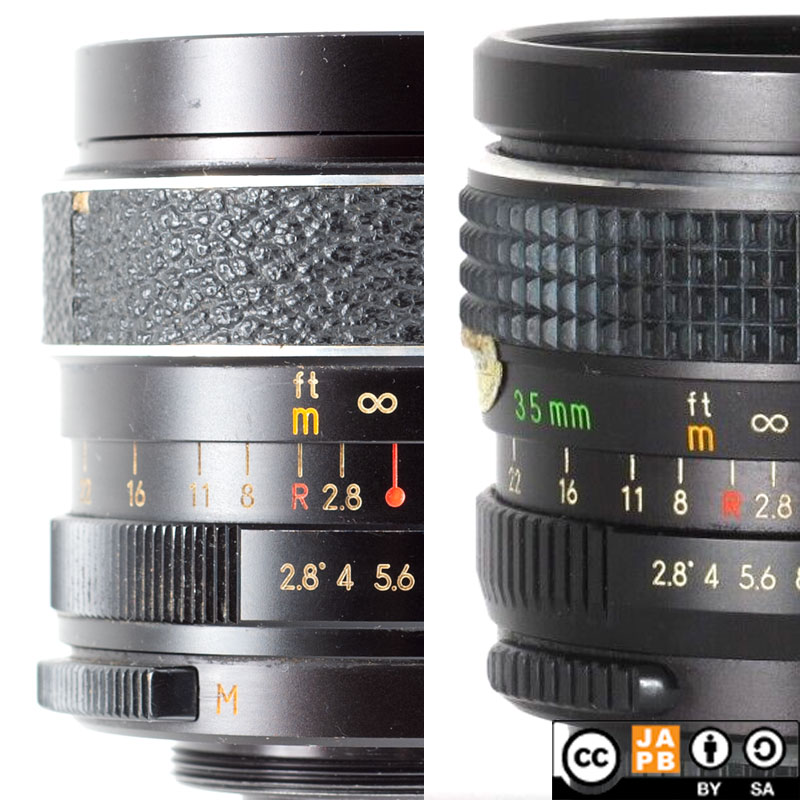Pekka Buttler, 01/2025

Specifications
The table below summarises the lens’ key specifications (measurements based on pictured sample):
| Brand: | Chinon | Lens name | Auto 1:2.8 f=35mm |
| Focal length(s)1 | 35 mm | Angle-of-view2 | 64° |
| Maximum Aperture | f/2.8 | In Production | unclear3 |
| Lens mount | M42 | Subfamily (if applicable) | –– |
| Length4 | 54,9 mm | Diameter5 | 62,1 mm |
| Filter ring diameter | 55 mm | Weight | 233 grams |
| Lens element count | ? | Lens group count | ? |
| Aperture blades (S/R/C)6 | 6 S | Focus throw | ≈270 ° |
| Minimum focusing distance | 587 cm | Maximum magnification | 1:13,8 (measured) |
| Has manual aperture ring | YES | Has Manual focus ring | YES |
| Aperture mechanism type | Auto/Manual8 | Aperture click stops9 | 2.8-4•5.6•8•11•16-22 |
Further notes:
• This M42 auto aperture lens has a M/A aperture mechanism switch and a pin in the mount used to facilitate aperture automation.
• I have not been able to find a description of the optical recipe (elements and groups) for the pictured lens.
• Chinon offered at least three different versions of the 35 mm f/2.8 lens in M42 mount. See ‘versions and origins’
Versions and origins
Chinon did not manufacture its own lenses (Chinon focused on camera manufacture), instead sourcing its lenses from various Japanese lens manufacturers, including Tomioka.
There are (at least) four different versions of “Chinon 35 mm f/2.8” lenses in M42 mount.
Version 1 is the “CHINONFLEX AUTO REFLEX 1:2.8 f=35 mm” It has a 55 mm filter thread, an M/A switch and is not multicoated. Its focus ring is typically a pyramid-pattern rubber ring.
Version 2 is the “AUTO CHINON 1:2.8 f=35mm)” [this lens]. It has a 55 mm filter thread, an M/A switch and is not multicoated. Its focus ring is typically a faux leather rubber ring.
Version 3 has the same name ring but a slightly modernised barrel design (the outward dimensions stay roughly the same) with totally redesigned control surfaces (focus ring, aperture ring and M/A switch). Importantly, there are several samples of Chinon 35/2.8 lenses that are hybrid forms (combining traits of versions 2 and 3, indicating that Version 2 and Version 3 share a genealogy). The focus ring patterning is a wedge pattern.

Right: Version 3
Very likely both Versions 1, 2 and 3 and were manufactured by Tamron10. Also, all these versions exist sporting other brands than Chinon11
Version 4 is the “CHINON 1:2.8 f=35 mm multi coated” (“multi coated” is sometimes abbreviated “multi c”). It has a tapered design (narrowing evenly towards the front), a 52 mm filter thread, an M/A switch and is multicoated. The origins of this lens is unknown.
Version 4 is reported to have a 6 elements in 6 groups design, but the design of the other versions is not certain.
After Chinon migrated to using the Pentax K mount, there was also a version for the Pentax K mount made (named “AUTO CHINON MULTI-COATED”)
Chinon company profile
Chinon is known to still photographers as one of the more advanced 2nd tier Japanese cameramakers. From 1971 to the late 1980s Chinon was known to enthusiast photographers the world over for combining technological advancements in cost-effective cameras bodies. See more details in the Chinon company profile.
Adapting
If you want to natively mount this lens you need to find a functioning m42 mount film camera. Luckily that should be relatively easy as m42 bodies were produced in their millions and most of them lack features that are especially likely to have deteriorated to the point of making the entire camera inoperable.
Adapting this lens to a mirrorless, full-frame digital camera is a breeze thanks to the lens having full manual controls (aperture ring, focus ring). You simply need a dumb adapter from m42 to your mirrorless system (And set the lens in manual mode to be sure the aperture works as you intend).
Due to the medium flange focal distance used by the m42 mount (45,46 mm), whether you can adapt this lens to dSLR/SLR mounts depends on which dSLR mount: Canon EF, Four Thirds, Minolta/Sony A and Pentax K can mount m42 lenses using a simple adapter ring. Nikon F on the other hand is not as problem-free, and – to retain anything near infinity focus – the adapter will necessitate corrective optics. In all cases, your camera will work only in stop-down metering.
Footnotes
- Focal length is (unless stated otherwise) given in absolute terms (not in Full-frame equivalent), and according to the manufacturer’s naming practice (which does not always reflect the lens’ actual field of view). For an understanding of whether the lens is wide/tele, see ‘Angle-of-view’. ↩︎
- Picture angle is given in degrees and concerns the diagonal picture angle. Rule of thumb:
> 90 ° ==> Ultra-wide-angle
70–90 ° ==> Wide-angle
50–70 ° ==> Moderate wide-angle
40–50 ° ==> ‘Standard’ or ‘normal’ lens
20–40 ° ==> Short tele lens
10-20 ° ==> Tele lens
5-10 ° ==> Long tele lens
< 5 ° ==> Ultra-tele lens ↩︎ - Documentation (e.g. brochures) of Chinon lenses are scarce and manuals are of no help in trying to date Chinon lenses as pictures in manuals surprisingly often show lenses that differ from those that were actually produced. Hence, dating these lenses is surprisingly difficult. ↩︎
- Length is given from the mount flange to the front of lens at infinity. Measured unless stated otherwise. ↩︎
- Diameter excludes protrusions such as rabbit ears or stop-down levers. Measured unless stated otherwise. ↩︎
- S=straight; R=rounded; C=(almost)circular at all apertures. ↩︎
- According to the focus ring, the minimum focusing distance is just short of 50 centimetres, but I measured minimum focusing distance to be 58 cm. ↩︎
- Alike many M42 lenses, the Chinon has a switch to choose between Manual and Auto aperture. ↩︎
- Numbers equal aperture values on aperture ring; • intermediate click; – no intermediate click. ↩︎
- The Likeness between versions 1 and 2 and the Tamron-F 35 mm f/2.8 is more than coincidental. ↩︎
- Specifically (based on sleuthwork), the following lenses are identical to either versions 1–3: Avanar 35mm f/2.8; Pallas Magenta AM 35mm f/2.8; Petri 35mm f/2.8 C.C Auto; Auto Revuenon 35mm f/2.8; Rexagon 35mm f/2.8 Automatic ↩︎